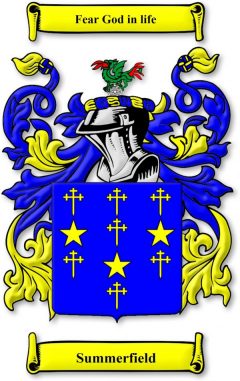George William Summerfield
1907 – 1998
Growing Up
It was not an auspicious start for my father, George William Lee, yes that’s right, at birth he was a Lee. Not the brightest of beginnings for me with lofty aspirations to research the family history of Summerfield, I could just as easily have been called Lee all my life, as would have been my children. I first had the inclination to research the family tree when I was in my early thirties, around 1980, I mentioned this fact to my mother one time when I was visiting suggesting that a good place to start I had been told was to interview living relatives. She put me off at that time with the revelation that my father had been born out of wedlock, a fact that he was particularly ashamed of and wouldn’t welcome me either knowing or discussing with him. This particular ‘skeleton in the cupboard’ had been a well-kept family secret up until then, even my elder sister Sheila, I found out later did not know about it, and she was 13 years older than me.

The scant information my mother gave me was that at the time, this must have been around August 1906, my Nana Summerfield, or Sarah Lee as she was at the time, was 18 and living with her parents William Lee and Elizabeth (nee Young), at 12 Eden Street, West Hartlepool, Co. Durham. She was employed in a ‘Big House’ in the village of Greatham, which is just outside of West Hartlepool and just a few miles away from where they would have lived. Her occupation on my father’s birth certificate is listed as Dressmaker so that might have been part of her employment, there was a history of women in the family being in ‘service’ so she very likely was a domestic of some kind. The story as told to me was that another member of the staff made Sarah pregnant, a groom is what I can recall being told. Whoever it was they can’t have accepted the responsibility and Sarah was left holding the baby so to speak. That is all the information I was given, I don’t think my mother knew any more, she would only have known what my father might have told her I am guessing.
But it was enough to put me off taking my family research project any further. Years later, after my mother had died, in 1990, and shortly before my father died in 1998, he did share with me the information that his birth name was Lee and that he had taken assurance from a solicitor that our inheritance wouldn’t be compromised by the fact that he had chosen to live his life as Summerfield, rather than Lee. Toward the end of his days he became concerned that his Will would be invalidated because of this fact but was assured by his Solicitor that you can call yourself anything you want as long as it is not for criminal purposes. It was an uncomfortable conversation for him to have with me and I chose not to embarrass him further probing for more details that he might have known. Perhaps I was wrong about that, because now in 2012 all the trails are stone cold, and the people who might have known something long since gone.
I did have a bit of a search into ‘big houses’ in Greatham around that time to see if I could get any clues as to my ‘blood’ grandfather. In the 1901 census, so some five years before the event, there were two ‘big houses’ that are perhaps significant, Ashfield House and the one that stands out for me Greatham Villa, run by Harry Cambridge a Market Gardner and Seedsman. In that 1901 census there were nine residents in Greatham Villa of which included four servants, one was a General Servant a Domestic, two more were Gardeners, and the fourth an Agricultural Horseman, James W Mankeden, 19, who looked after the horses and born in Pickering, Yorkshire which is of course very close to where Sarah’s mother Elizabeth Young was from. Interestingly, I can find no more instances of James W Markeden in any records before or after this entry in 1901. Could this be the man who was my true blood grandfather?
By 1911 the house name had changed to The Villa, Greatham, and Harry Cambridge was still there running his business with the help of different servants. So, this may well have been the ‘Big House’ that my Grandmother was working in as a teenager in 1906 when she became pregnant, but no way to ever prove it.

The records show that at the time of my father’s birth Sarah Lee was staying in the city of York, not 12 Eden Street West Hartlepool where her parents and family lived. I am still intrigued by my father being born in York rather than West Hartlepool. It is perhaps understandable that her mother Elisabeth Young would have sent her off to have the baby, perhaps to stop wagging tongues, and by that time in 1906/7 Sarah’s sister Mary I know was living there by this time. Mary’s first child, Martha (Pattie) father unknown, was born in West Hartlepool in 1901, but after marrying George Hutton in 1903 the second two children Lillian Mary (1904) and Joseph Valentine (1910) were both born in York. I am assuming that my grandmother would have gone to stay in York with Mary and George for her confinement. The address on my fathers birth certificate in May 1907 is 51 Amberley Street, but by 1911 Mary and George were living at Carnot Street so not certain that Amberley Street would have been their address in 1907.
This also begs the question for me as to whether Mary moved to York from West Hartlepool to marry George Hutton in 1903 or whether she had moved with her baby sometime after 1901 and then met George whilst there. If it is the latter option, which I think I favour, then what was the connection, why York and who did she stay with. Elizabeth Young’s elder brother George had moved from the family home in Terrington to York sometime after 1881 and was a Goods Guard on the Railway by 1891 after marrying Jane Moss, a York girl, in 1890. They had two children together before George died in 1892 just 30 years old. Jane remarried in December 1893 to Arthur Woodall a Railway Wagon Painter. In 1901 they were all living with Jane’s father just around the corner from Amberley Street. When George Hutton and Mary married in 1903 Arthur Woodall was one of their witnesses, George Hutton was also a Carriage Painter with NE Rail Co.
In this scenario Mary moved to York with baby Pattie and stayed with her Auntie Jane (Moss then Young then Woodall), where perhaps she was introduced to her future husband, a workmate of Arthur, marrying him in 1903 and settling nearby. When pregnant Sarah comes to stay perhaps they are in Amberley Street and that is why it is on my fathers birth certificate. All the York addresses over the decades are generally in that Holgate area, close the the Railway Workshops and only minutes away from each other.
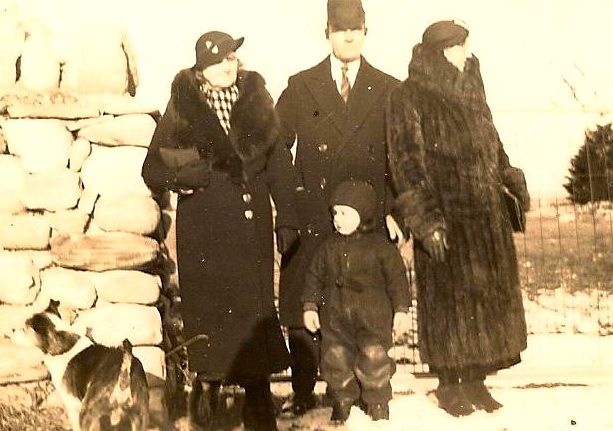
This is the earliest photo I have been able to find of my father, it was given to me by someone in the family but we don’t know who might have taken the picture. The handwritten inscription on the back of the photo says ‘Aunty Ciss, Uncle Bill, Aunty Sarah and George. I am guessing at the age of my father to be about two, which would make the year about 1909 and his mother Sarah about 21. Uncle Bill might be William (aged about 27) the brother of John Summerfield (who Sarah marries in 1911), and Aunt Cissie could be the sister Catherine (aged about 25). If Sarah Lee took this photograph, which I think she might have because the handwriting for the inscription on this and another photograph and on a copy of a 1919 British Army Service Record I have are all the same, then the Aunty Sarah mentioned might well have been another sister of John. But that sister would only have been about 14, I know they did look older in those days but I don’t think a fourteen year old would have been wearing a fur coat. Maybe the younger Sarah took the photograph, but that idea has flaws as well.

I have little information about my dad’s childhood, other than at the time of the 1911 Census he is recorded as the three year old grandson living at 12 Eden Street with his mother’s family, her father William Lee aged 52, his wife Elizabeth 48, and Sarah’s younger brother Herbert who was also 3. They also had Elizabeth’s widowed mother Mary Young boarding who was 87. Sarah is actually recorded as being at Briadene in Stockton Road, Foggy Furze, working as a Domestic Servant for the Forster family, a prominent Hartlepool Timber Merchant. The two addresses are quite close together so Sarah might not necessarily have been a live-in servant, but even if she did, it wasn’t far to get home and see the family.
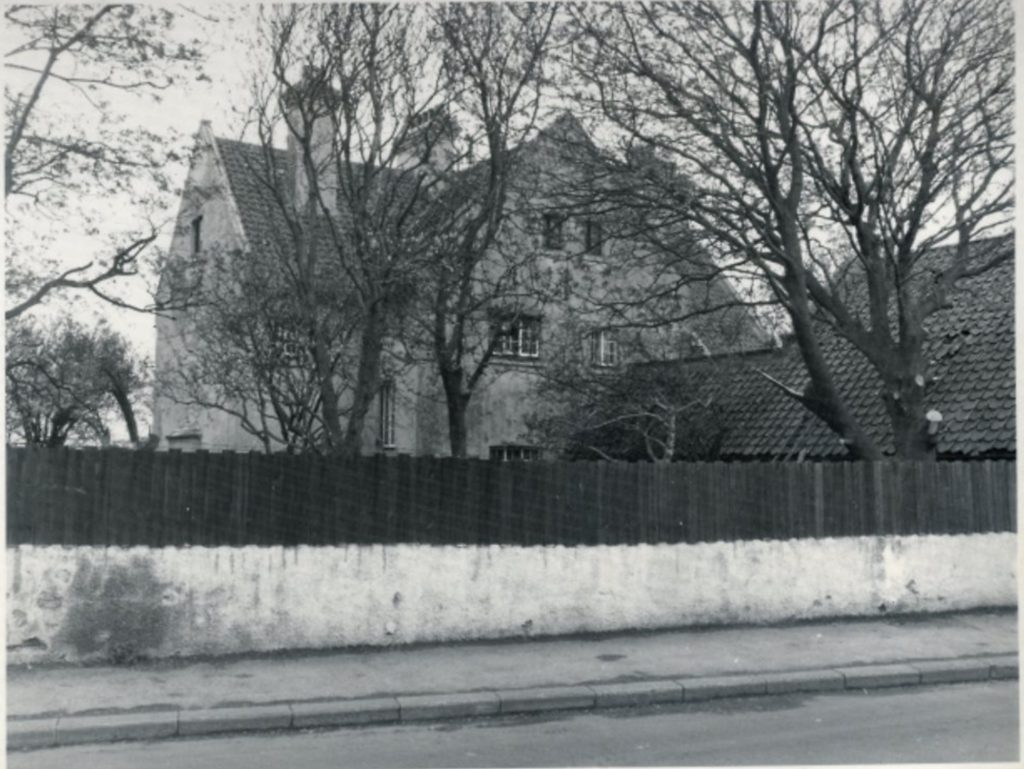
The date of the 1911 Census was Sunday 2nd April, and just over a month later on Monday 15th May she married John Summerfield, whose family had been living just down the road at 39 Eden Street for at least ten years. John had a window cleaning business, which he ran with his younger brother Robert. By November 1915 I have John and Sarah and three of their children in their own house at 43 Benson Street, West Hartlepool. I have marked in red on the street map above the Eden Street and Benson Street locations in the area and also that of Colenso Street which is where Sarah, my Nana Summerfield, lived along with her daughter Sarah (my Aunt Sadie) at number 21 and next door at 19, Isabella (my Aunt Bella), all during the years I was growing up. So in 60 or 70 odd years much of the family hadn’t moved more than a couple of hundred yards.

This photo, I am estimating as having been taken toward the end of 1913, because the first girl born to the couple was Catherine (Kitty) on May 31st 1913, and in this picture she does look to be fairly recently born. We can see more of the young George now and I would think that he would have been about six and a half at this time.
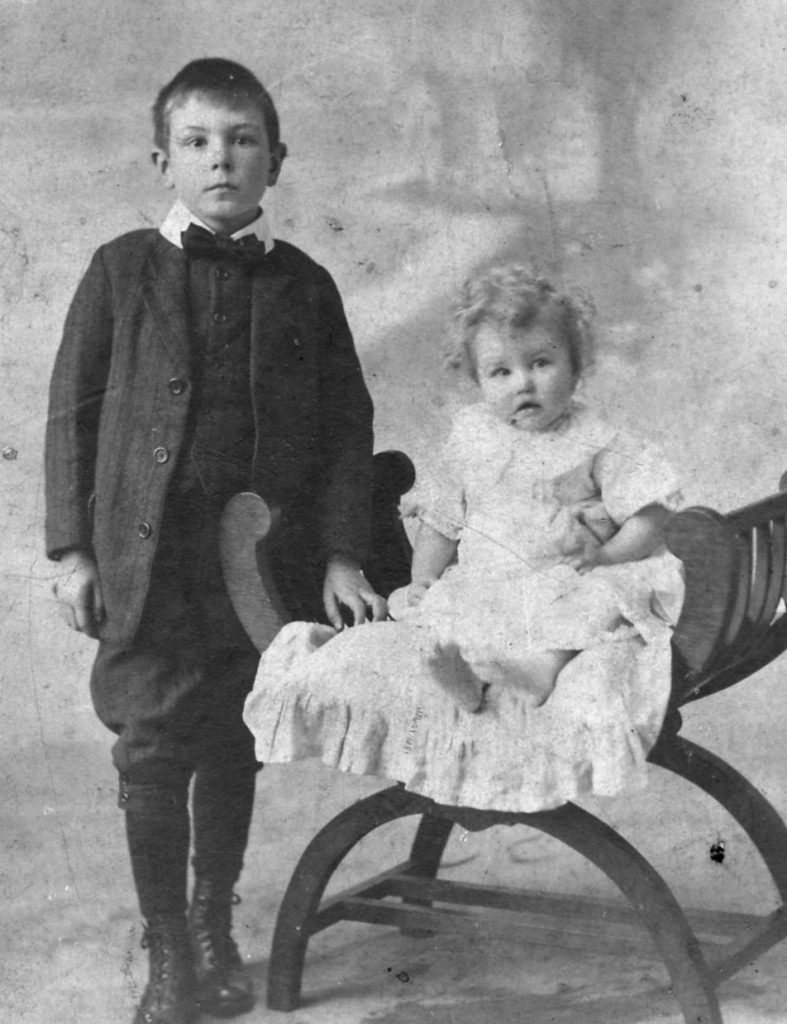
This next picture, I am estimating to be about mid 1914 as Kitty now has a bunch of blonde curly hair and would probably be about twelve to eighteen months. The third photo of this little set, must be dated sometime in early to mid 1916 I would think and for two reasons. First, Sarah (Sadie) born 19th Jan 1915 is in the photo aged perhaps around one year old, and secondly John is in military uniform. He enlisted for the army in November 1915, called attestation, and was then mobilized for action with the Durham Light Infantry in July 1916. I am guessing that this family portrait would have been taken just before that and because he was embarking shortly to join the war effort in France. George looking splendid in his own uniform just like his adopted Dad. Sometime in the period since Sarah’s marriage to John my father took on the surname of Summerfield rather than Lee, although a formal adoption had not taken place.
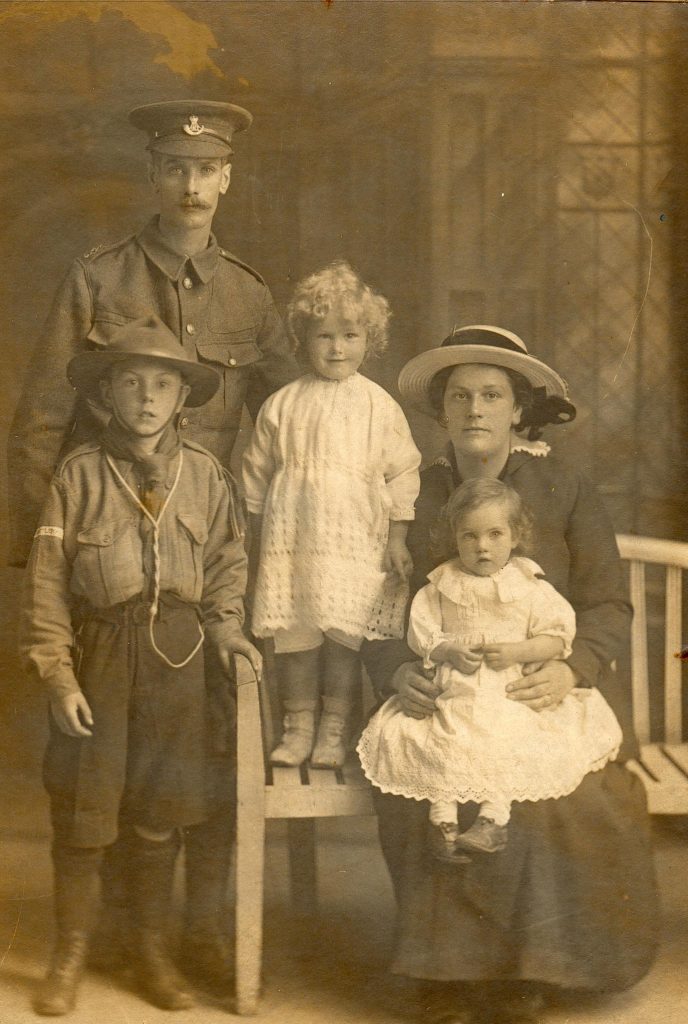
My father would have been just turned nine years old. Sadly John would not return home at the end of the war because according to Army records whilst serving with his unit in Archangel, Russia, he took ill on 22nd January 1919 with Pneumonia. He is again recorded on the 22nd January as being ‘dangerously ill’, and finally on the 25th as having ‘died’. I also find it so sad that he died after the end of the war, when the worst of the conflicts had been finished for over two months.
My grandfathers silver fob watch was returned to his wife along with I would imagine other of his effects, and that watch was given to my father when his mother died in 1973. My father gave it to me before he died in 1998 and I have no doubt I will pass it on at the right time.
The only story my father ever told me about John Summerfield, and at that time I would have believed that John was his blood related father, was about his death. I can’t remember for certain but at some point I must have asked how his father had died, and he told me that he had been in Russia and was on Sentry Duty, which of course does fit in with the unit being a Garrison Guard Battalion. He told me that the guards would whistle to each other during the night to let each other know that things were OK. When there was no whistle from John on this occasion they went to find out what was wrong and found him frozen to death. I know now that the very last part wasn’t exactly the case because he died in hospital, but perhaps he was found near to death, he certainly was very ill and died quickly afterwards. Also, this may well have been the story that this 11-year-old boy was told at the time and remembered all his life. I have probably had more access to military records and information than either my dad or his mother would have had at the time. Interestingly, my cousin Susan Coates, who is the daughter of my Aunt Kitty (Catherine the first born of John Summerfield and Sarah Lee) told me recently the exact same story about Johns death that my father told me.
During those First World War years of 1914 through 1919 my dad would almost certainly have attended Lister Street School, which had opened as a brand new school around 1900, and was just at the bottom of Benson Street. He told me on more than one occasion that at the start of his school holidays (I am guessing the summer ones rather than the winter) he would cycle from Hartlepool to York and stay there for the duration of the school holiday at his Auntie Mary’s, Sarah’s sister Mary Hutton (nee Young Lee). As he pointed out to me, this was a bit of an expedition in those times. His bike was some old boneshaker of a hand-me-down, with hard leather saddle and fixed rear wheel instead of gears, something like the one in the picture below. That journey would have been around 60 miles, my Dad told me that it would take him all day. He would set out from Hartlepool in the morning with a bottle of water, a sandwich and some clothes in a rucksack, and would be at 39 Carnot Street, York by the end of the day. He would stay with Aunt Mary and her family for the duration of the holidays and then make the journey home in time for school. He must have made that journey quite often because he told me that he looked on Mary’s children like they were his brothers and sisters, not surprising as Joseph was three years younger, Lillian three years older and Martha (Pattie) six years older.

From about June in 1919 I have Sarah and her children living at 8 Eden Street, presumably to be close to both her and John’s families, who were still living at numbers 12 and 39 respectively. My father would be around twelve now and I have few facts about him or the family over the next few years, I do believe that both during the war and afterwards, Sarah continued with the window cleaning business, carrying the ladders and cleaning windows herself. Sarah started receiving the War Widows Pension, for herself and the four children and there is a figure in the Army Records of her being awarded 4 8 19 per week with effect from 4 8 19. This is somewhat confusing because both the numbers are the same. The date looks to be about right at 4th August 1919 but the amount can’t be correct as there was only 12 pence in a shilling so the 19 would have been wrong. I did a little bit of research and it seems that in 1919 a widow with four children would actually have received about £1 3 shillings a week, craftsman of that time might have expected to earn around £3 6s 10p for a 50 hour week, so £1 3s wouldn’t on its own make up for the loss of a wage and the window cleaning was possibly essential.
In the 1921 census George is still called Lee, living at 8 Eden Street and attending Lister Street School. I also unearthed this little snippet from the Hartlepool Northern Daily Mail, Monday 5th September 1921 at which time George was living with his mother in Eden Street. ‘For gaming with cards in Back Eden Street on August 22nd, John S Tiplady (22), Harry Catson (16), Edwin Smith (15), and Thomas Ness (13) were each fined 10s.‘ Edwin Smith was later to be Best Man at the wedding of my Mam and Dad in 1933, he must have been a long term friend lasting from his schooldays through into adult life.
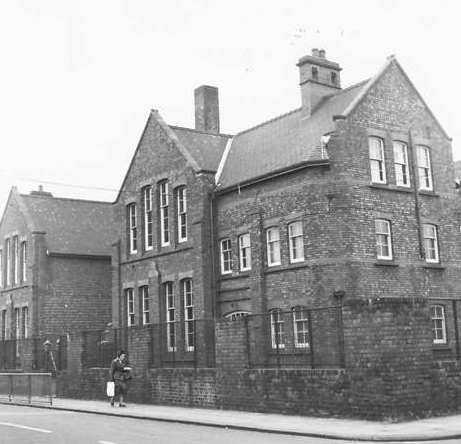
Army Life
At 17 years old, and on 11th September 1924, my dad enlisted for the regular army at the Durham Army Recruiting office. My mother had always described my Dad as having run away to join the army, I don’t know if that is true or not but he did lie about his age to enlist. His recruitment records show him as having a birth date of 28th May 1906 rather than 1907. It is a fact that he received his Army Pension when he was 64, a year before he retired with a state pension. His occupation on joining is described as ‘labourer’, but I have no idea what he was doing at that time. He enlisted in the Royal Regiment of Artillery as a Gunner for 6 years of Army Service and 6 years of Reserve Service and had the Military Serial Number of 1058636. His Army life proper started 2 days later when he started his 12 week training programme with the 2nd Training Battery RA Depot at Woolwich. He did well in his training as his records attest and he passed the Army Certificate of Education Third Class on 29th October 1924 and the Second Class on 19th December. His training was successfully completed on the 7th January 1925 at which time he was posted to the N Battery Royal Horse Artillery. I loved the ‘General Remarks on Recruit’ from the Commanding Officer on the completion of this 16 year olds training.
“An average recruit. Has worked well and tried hard. Could improve his turn out”.
Not quite got into the spit and polish style of the British Army at this point.

The Royal Regiment of Artillery was formed in the Royal Arsenal in 1716 and the soldiers were billeted in barracks there. Between 1776 and 1802 these splendid new barracks were built on Woolwich Common. The buildings still house soldiers from the Royal Artillery. During World War I the Arsenal, the main armaments factory in the country, employed about 80,000 workers. On the lst January 1924, just before my dad had enlisted, all artillery in the British Army (horse, field and garrison) were re-organised into a single regiment, the Royal Regiment of Artillery, with the Royal Horse Artillery units retaining their title and separate badge. N Battery in particular had an illustrious history and in 1901 N Battery had the honour of bearing the coffin of Queen Victoria. At the outbreak of the First World War, N Battery deployed to France and fought in many actions, including the battles of Neuve Chappelle, the Somme, Cambrai and Hailles. N Battery claimed the highest number of rounds fired in one month by a single Battery when in August 1917, the six guns fired 115,360 rounds in support of the Canadian Corps. N Battery remained in the thick of the fighting until the signing of the Armistice. In 1920, N Battery had the honour of bearing
the coffin of the Unknown Warrior to Westminster Abbey and the Coronation of King Edward VII and on 18th October 1926, N Battery was awarded the honour title “The Eagle Troop”.
On 11th May 1938, N Battery became mechanised and was amalgamated with L (Néry) Battery RHA to form a Field Battery within 2 RHA. lt was as L/N Battery that it returned to France in 1939 at the outbreak of the Second World War as part of the British Expeditionary Force and fought in France until it was evacuated at Dunkirk in 1940. But more of that later.
There is an entry in his service records for 10th May 1926 stating ‘Injuries to face while on duty. Not to blame.’, and I think this might refer to a story he told me that took place during his training. The training on this occasion was to do
with loading and firing a field gun, probably a 4.5 inch Howitzer. He had carried out his part of the operation, loading the shell into the firing chamber I believe, and had stood back ready for the shot to be discharged. But not far enough, the recoil of the gun barrel at the point of firing was so close to his head without touching him that the force of the air pressure knocked him over. All of his comrades to a one believed that he had been hit by the gun and must be dead. He wasn’t, obviously, but more by very good luck than good judgement. I didn’t make the connection at the time, but my dad always watched the Royal Tournament at the Earls Court Exhibition Centre when it was broadcast on TV as I was growing up, and in particular he liked the he Royal Navy’s command field gun competition. This was a contest between teams from three Royal Navy commands, in which teams of sailors compete to transport a Field Gun and its equipment over and through a series of obstacles in the shortest time.

My father was stationed in the UK up until 8th October 1926 when he was posted to India. I have photos of him in India but not much factual evidence of his time there, except for a cookery certificate issued by the Army School of
Cookery for India in Poona on 18th April 1927. He was declared Category A and considered competent as a British Army Cook. Poona (now known as Pune) is a city about 100km south-east of Bombay (now Mumbai), which was a popular social retreat for residents of Bombay as well as formerly the largest garrison town in the Deccan (Plateau) for the British Army.
My Dad related a number of stories of his life in the army to me and I must admit that because he was in India both before the Second World War and again during it, I am not certain which stories relate to what period, but I have
made my best guesses. The two photos I have here I am fairly sure would relate to the period in India 1926 to 1931, mainly because he still looks quite young and would only have been between 19 and 24 years old. I am sure it would have been around this time when he described his living arrangements, it sounded like a typical army hut accommodating about a dozen soldiers. They all had their own bed space and cupboard and used to pay a penny (old 1d) each per week to a young lad from the neighboring village who would come along at daybreak, make up an urn of tea, shave each of the soldiers while they were in bed
sleeping and then wake them up with a cup of tea.

circa 1920-30
I found this picture when researching Army life in India, it was taken in 1928 and must have been identical to the sort of accommodation my dad would have been in. I don’t know what they were doing when they were on duty, but they did seem to have a lot of leisure time. Quite a bit of sport from what I can recall, he said they would make a football pitch by clearing a suitable area and then wash the mud down with water with brooms to get it flat and smooth. Then let it bake hard in the sun until they had the playing surface needed, put up some
posts, mark the lines, and voilà a football pitch. I have also seen old RHA
photographs online of cricket, hockey and tug of war teams, so, lots to do it
would seem.

I know that he learned, to some degree, to ride a horse because he related a story of being trained and that if you fell off the horse you were immediately told to get back on, regardless of how you were feeling or hurt. Something to do with conquering the fear I guess. He also confirmed a story that I have heard elsewhere of the men going to ‘Tea Dances’, where there weren’t any ladies. As he explained it, many men enjoyed dancing, it was good recreation, and if they had to dance with each other with one taking the role of the lady, then that would be better than not having the opportunity to dance. My dad said that they hardly ever saw white ladies, just the few that might be wives of officers and living out in India with their husband, and these were very much off-limits.

George (centre front row) with N Battery colleagues circa 1926
The only other story that I recall from around this period in India I think, was the one involving the latrines. Dad explained that in the army in India, like many other places, they had communal latrines. There were many different forms but the one in this story was a large diameter pipe running through the latrine with cutouts in the top surface with seats and a constant supply of water running through the pipe to take away the waste.
The game apparently was to wait until there were a number of occupants using the facility, and then introduce into the pipe from a point outside the latrine a
burning ‘boat’ of paper. This burning ‘boat’ would then sail its way down the pipe on the current giving the occupants, one after another down the line, that
burning sensation on the backside. There is no way of knowing it its true or even elaborated, but I enjoyed the tale. This photo I found on the internet might suggest it was more than likely true.

An interesting little titbit of information that I can add here, gleaned from a tatty old certificate that had been filed with his Soldiers Service and Pay Book and a medal in a box, was that on 22nd November 1930 he was initiated into the Royal Antediluvian Order of Buffaloes. The exact inscription on the back of the medal, called ‘Jewels” I believe was:
‘Presented to Bro GW Summerfield Initiated In The Land Of The Five Rivers Lodge No 4863 On The 22nd November 1930.’
A few months later the certificate states that:
‘This is to certify that Brother Summerfield of Delhi Spearman Lodge No 6748, initiated on 22.11.30 has been examined by The Examining Council of the Delhi Spearman Lodge No 6748 this 25th day of January 1931 and pronounced duly qualified to stand an election for the Second Degree.’
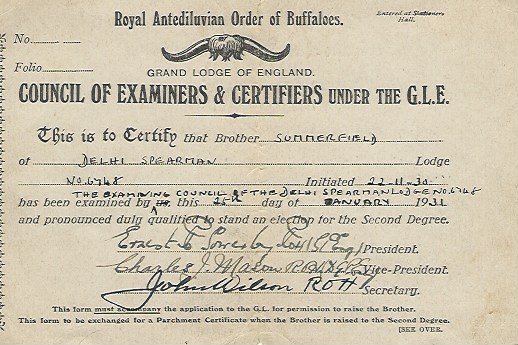

The Royal Antediluvian Order of Buffaloes (RAOB), like the Freemasons is one of the largest fraternal organisations in the UK and is known as the Buffs to members. The RAOB was founded in August 1822 at the Harp Tavern, Covent
Garden (opposite the Theatre Royal, Drury Lane) by the artist, Joseph Lisle and comedian William Sinnett along with other stage hands and theatre technicians who were unable to gain access to their trade guild. Originally the members were all in the theatrical profession and the meetings were essentially social, the original initiation was probably intended as a burlesque on Freemasonry. The Buffalo title related to a music hall song ‘We’ll Chase the Buffalo’. During the 19th century the Order spread throughout the British Commonwealth and was more than likely to be found with lodges in India, and the name of my fathers second lodge probably came from the fact that during the Indian mutiny of 1857, the 9th Queen’s Royal Lancers earned the name the Delhi Spearmen, a name which is believed to have been given to them by the mutineers themselves.
Land of the Five Rivers is generally referred to as the region of the Punjab in the north west of the country, so perhaps he was stationed in that area for a while. On the other hand Delhi is more north central so he could have been there also.
He was coming to the end of his six years service at the beginning of 1931 so if he did stand for election for the Second Degree it would have been back at home in West Hartlepool, and there is no further evidence that it did. There was however a RAOB lodge and social club in West Hartlepool, in Easington Road in fact, perhaps just a mile from where I grew up. I did go there from time to time, first as a fifteen year old member of the Hartlepool Public Brass Band, when we used the official function room upstairs for band practice, and a few years later for their excellent and inexpensive Camerons Strongarm beer.
Just to put some balance to dad’s service in the Army, and particularly after his less than glowing first Commanding Officer review, I record here some further reviews copied from his Service Records:
Rank Date Conduct Employment General
Gunner 14.9.1926 A clean smart man; intelligent.
Gunner 15.9.1927 Good. Cookhouse. Smart and keen, is doing well.
Gunner 14.10.1928 Good Duty Keen – a good soldier, honest, sober,
reliable.
Gunner 22.10.1929 Very Good Duty Smart, clean and intelligent, a good reliable gunner
Gunner 4.11.1930 Excellent Duty A keen hard working man with plenty of intelligence. Can be trusted to do his job without supervision. Sober, honest.
Dad was posted back from India on 28th February 1931 and then finished his full time service on 16th March at Chatham in Kent with N Battery Royal Horse Artillery, transferring into the Army Reserve.
In his Regular Army Certificate of Service on transfer to the Reserves, noted that his Military Conduct had been ‘Exemplary’, and that he was ‘Intelligent, honest, sober and reliable. Hard working and gets on with his work without supervision’.
George William Summerfield
1907 – 1998
Between the Wars
Unfortunately while he was away in India dad lost more members of his adopted Summerfield family, first the brother of his father John, Robert, died in January 1926 at just 37, and then John’s father, William Summerfield, who
died in 1929 aged 77.
During the time that he had been away in the Army his mother had moved again, but not very far, moving with his three sisters from 8 Eden Street to 18 Eden Street. The following period is all a little vague other than for two
significant events. The 1931 census might throw a little more light on it, but at the time of writing that won’t be released for another eight years. On 7th August 1933 Dad married my Mother, Kathleen Owen as she was known, and on 10th May 1934 my sister Sheila was born. On the wedding certificate their witness was her sister Hilda and the Best Man was Edwin Smith who’s grandparents lived at 40 Eden Street while he was growing up and my fathers adopted grandparents lived at 39 during the same time. So, no doubt they grew up together, probably even went to the same school as Edwin was living at 8 Queen Street, not far away at all. As mentioned earlier in this section I did stumble across an interesting snippet when looking for background on Edwin Smith, this from the Hartlepool Mail, Monday 5th September 1921.
‘For gaming with cards in Back Eden Street on August 22nd, John S Tiplady (22), Harry Catson (16), Edwin Smith (15), and Thomas Ness (13) were each fined 10s.‘
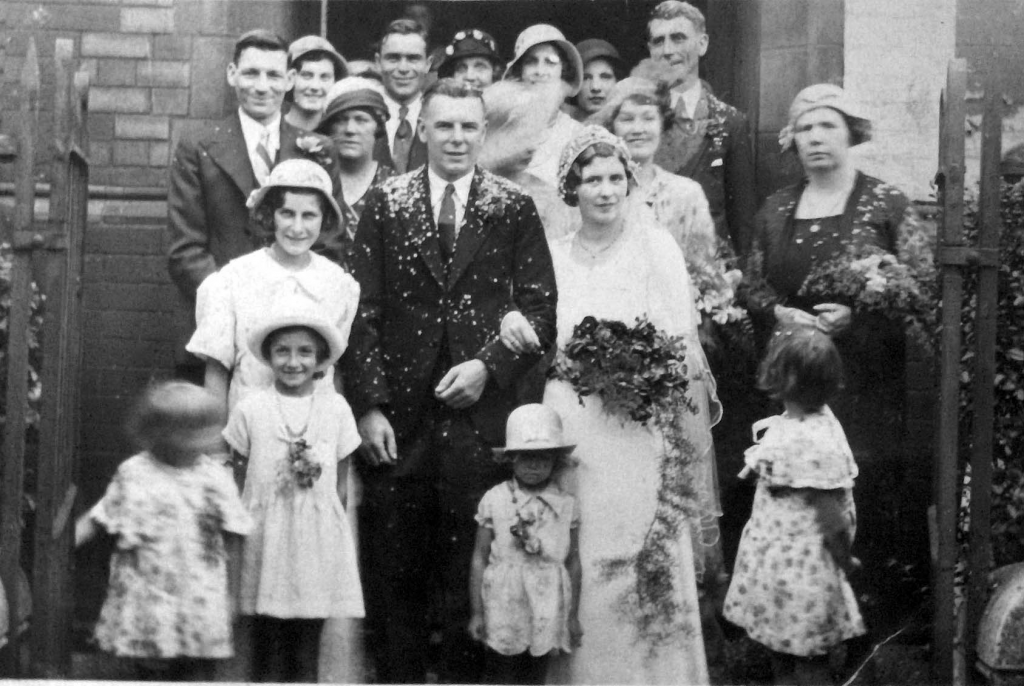
I can put some names to faces from this photograph of my Mam and Dad’s Wedding Day. Can’t help with lower front row young girls. On my Dad’s immediate right is his sister Isabella (Bella) b 1918, to his right shoulder is his mother Sarah Summerfield (nee Lee), to her right is Best Man Edwin Smith. Between the two heads is Sarah Elizabeth Summerfield (Sadie) Dad’s sister, b1915 and to her left her husband to be Walter O Potter. To the far left of the bride is her mother, Sarah Owen and on her right, behind my Mother is Dad’s sister Catherine (Kitty) Summerfield b 1913. On her right and mostly obscured by her hat is another sister of my Mother, Hilda b 1914. Onto the back row and above Catherine is father of the bride, my Grandad, Edward Owen, and the two ladies to his right his daughters Clare first b 1915 and Winifred b 1908.
I know little of how my mother and father met or how the relationship developed other than my mother once told me that at the time they were seeing each other she had another beau, and offer of marriage, and that my dad gave her the ultimatum to make her mind up, and she chose him. I have also gleaned from my historical records that my dad had lived with his mother and John Summerfield from about 4 years old in 1911 until 1919 at 43 Benson Street and
my mother was living with her parents in the next street at 24 Bentley Street. I also know that my mother’s grandparents, William Kelsey and Mary Jane, were living at 36 Benson Street around that time. In fact my mother, her sister
Winifred, and their mother Sarah actually lived there in 1911 while their father James Edward Owen, a Boilermaker, was away working in Belfast helping to build the Titanic. So it’s very possible the families would have known each
other when George and Kathleen were growing up. Also, and probably just as likely would be that they both would have gone to Lister Street School, which opened in 1901 and was just at the bottom of Benson Street. As it was a
junior and senior school they would have been going to school at the same time for a good few years.
On their marriage certificate my dad’s occupation is Insurance Agent, which I did know about from conversations growing up. He was with the Brittanic Assurance Company and when he died I did find amongst his papers, what they
called ‘Penny Policies’, life insurance policies that cost one old penny (1d) per week, collected in those days each week by your Insurance Agent. From memory I think there were three paid up policies in force, dating from around 1933,
for my mother, father and his mother Sarah. We cashed them in at the time and they amounted to a total of £849. By the time Sheila was born in 1934 he is recorded as a Window Cleaner, presumably working with John’s brother Robert
Summerfield in the family business.
The first address I have for them as a young family is 41 Richard Street, which was given on Sheila’s birth certificate. However I found an entry in the Hartlepool Mail on 16th March 1935 stating that ‘Miss G Wallett, Dressmaker, was advising clients that she had removed to 41, Richard Steet’, so it was probably at that time the family moved to 4 The Green, Seaton Carew. The move to The Green must have been accompanied by a change in occupation, I know from family stories that at some point my dad was a caretaker at a school when they lived in Seaton Carew. I have discovered that it was a small private school called Melrose School run by a lady called Miss Frederica MW Winfield, and its address was 4 The Green. My mother recollected once that my sister Sheila when she was little, would follow her dad around when he was working at the school. There was another benefit of that job because when she was old enough to go to school, Miss Winfield took Sheila on as well, presumably free of any school fees. In the 1939 Register, which because of the outbreak of WWII replaced the 1941 Census, my mam and Sheila are recorded as being at that
address with my mam’s occupation as housekeeper. I found the photograph below online and it was taken to commemorate the King George V’s Silver Jubilee celebrations on 6th May 1935. The group are standing on The Green
at Seaton Carew and number 4 is the building immediately behind the lady at the right of the group. Today it is two semi detached houses but perhaps back then it was all given over to the school. Interestingly, and this could be an
amazing coincidence, and with no way to prove it, but in 1935 my mother and father would have been living somewhere in that house, with my sister who would have been about a year old. The lady in the centre of the picture

